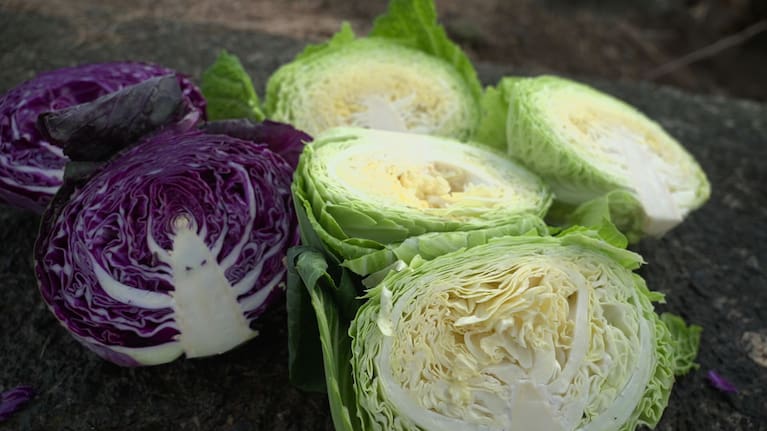They’re big, bland and take up far too much room in your fridge, but the humble cabbage is undergoing a resurgence in popularity — and New Zealanders are leading the charge.
In the fields of Pukekawa, the winter cabbage harvest was underway. Rows of purple and green and the crinkly-skinned savoy stood steadfast in the muddy ground surrounding it.
They’ve withstood hail and a weekend of torrential downpours, but not much harms the cabbage. That’s what makes cabbage a staple worldwide; it’s part of so many cultures, yet it's rarely celebrated.

Ask Aaron Balle, the Brassica manager at Balle Bros, what their harvest is destined for, and the simple answer is coleslaw. "Slaw" and mix salad bags — but mostly slaw.
It says a lot about how we consume this most basic vegetable: lather it in sauce and eat it by the bucket load. Or you can boil it to the brink of existence and coat it with butter — that’s cabbage.
But the world is noticing this sidekick salad, and perceptions around it are slowly changing.
The surprising sellout
In an old cinema on Whangamata’s main drag is the newly opened Camina restaurant. Its menu is a far cry from the fish and chips and fried fare that have long served the summer beach town.
"Good wood, good ingredients, and don't wreck the ingredients too much — just add a few flavours," said owner Rowan Crowe.
The simple open-fire approach has led to the small venue being booked out most evenings since its grand opening.
And the surprise star? They call it "cabbage".

"We're doing something seriously wrong when it is our most popular dish, or we're doing something really right," said Crowe.
Just calling it "cabbage" is a gross simplification of a dish that balances flame, spice and crunch in a way that most would have never experienced.
The cabbage is first marinated in herb and citrus puree before a short turn on the grill. The aim is to cook the wedge's outer ends and keep the crunchy texture inside. Then it’s plated with creamy labneh, chilli tomato jam and spiced almond dukkha.
Crowe’s open about cabbage being his favourite thing on the menu, although selling it to people initially was tricky. Most thought the matre d’ was trying to get rid of the cheapest item.
"Cabbage's got a name for itself. There's a low bar. People don't have high expectations of cabbage."
That was quick to change. In a short time, it became one of their best sellers, and people were quick to return for more.
"It turns out it's the most popular dish, and everyone comes back for it. Everyone's like, 'I never thought I'd say I'm back for the cabbage'."

Anyone who’s grown or bought a whole green cabbage will know it’s a lot of vegetable — a vegetable that can quickly take a permanent position in your fridge.
That’s where Niva Kay comes in. The Thames-based permaculture legend has spent her life growing organic vegetables for the region. Kay and her husband, Yotam, recently penned a guide to making those vegetables last.
The Abundant Kitchen covers everything from ferments to pickles and preserves, making her the perfect person to teach the art of sauerkraut.
“When it's the season when we've got a lot of cabbages, we make a lot of kraut, and it keeps so well it," she said.
Within 10 minutes, she'd taken a whole cabbage and, adding only salt, forcefully kneaded the liquid from it.
The loud crunches slowly disappeared, and a brine formed at the bottom. Kay added calendula and dill to the mix. It’s not necessary, but it adds to the flavour that will be far better than anything you buy in the supermarket for ten dollars a jar.

Through years of experience, she’s mastered the art of working with good bacteria – an art she says many of us are scared to experiment with.
“If you keep to some basic strategies like you keep everything clean, you keep everything under your brine, you know, make sure you've got the right amount of salt," she explained.
“It's so easy; it's just ridiculously easy. This is literally cabbage and salt in a jar.”
It’s ready to ferment once the mix is weighted down, covered with brine and sealed with an airlock lid. It will be ready in a week but can be kept for far longer than that as the flavours develop.

Back at the Balle Bros fields, Aaron had gathered three of his finest cabbages for a quick taste test.
They’d been picked for less than 10 minutes when he sliced them open with an intimidating machete stroke – followed by a twist in the cabbage’s heart.
It was cabbage at its simplest, away from the pottle-dressed coleslaw of our big fast-food chains — nothing like Nana’s butter-boiled side dish.
A simple mouthful of cabbage that was quite simply delicious. A sweet yet tender crunch that begged the question: Has cabbage had an unjustified reputation all along?
Right now, cabbage is as cheap as it'll get. The season is in full swing, so let's put it at centre stage, build a pedestal and make this little side a hero of your next meal — it’s earned it.


















SHARE ME